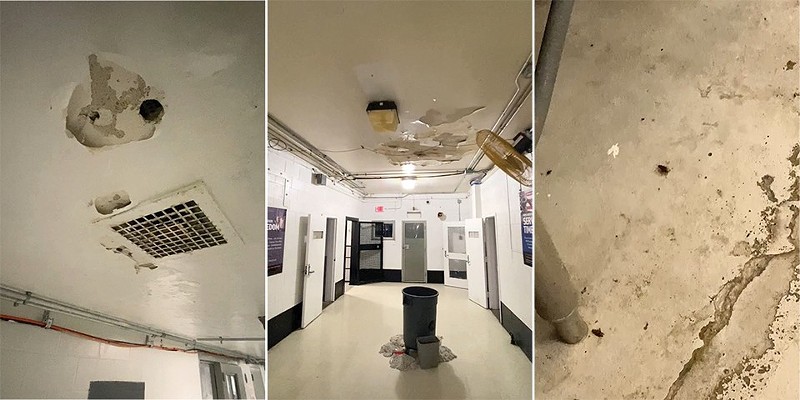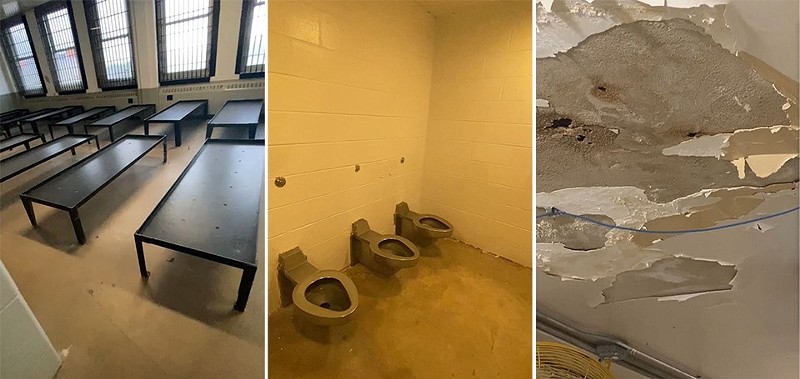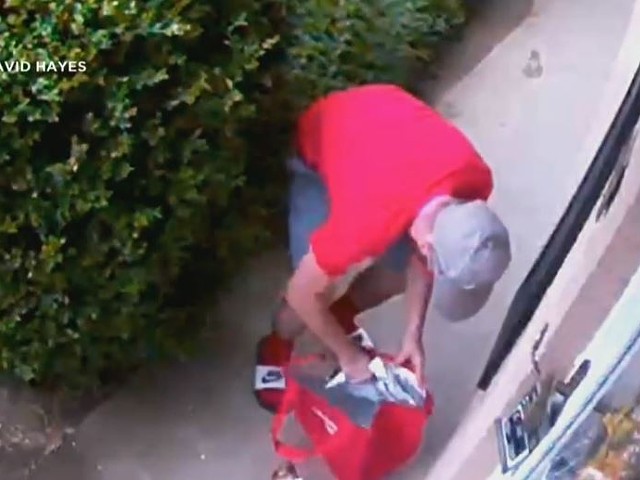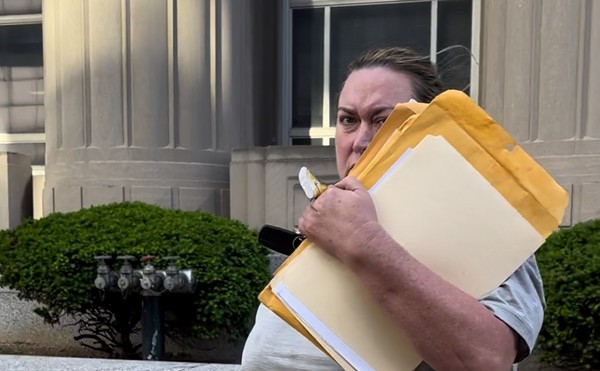
SCREENSHOTS VIA HEATHER TAYLOR VIDEO
Three scenes from tour inside the Workhouse jail show (from lift to right) holes in a hallway ceiling, rain leaking into buckets, and a bug on the decrepit kitchen floor.
Rare video footage recorded in the most decrepit areas of St. Louis' Workhouse jail reveals signs of neglect and disrepair in the 55-year-old facility. The footage was released last month by the administration of Mayor Tishaura Jones, who has promised to close the jail by July 1.
The footage is referenced in this week's RFT cover story, which examines the complicated history of how public tours into the jail reflect the policies and perceptions of city leaders tasked with deciding its future.
The roughly 27-minutes of footage — which is embedded in full at the bottom of this story — is comprised of several clips that trace a path through the jail's kitchen, dining room, gymnasium and hallways. The video documents rainwater leaking through hallway ceilings, as well as sections of the jail that have been shut down since 2017 by superintendent Jeffrey Carson.
On May 7, Carson acted as Workhouse tour guide for Heather Taylor, a senior advisor to the city's director of public safety Dan Isom. Using her smartphone, Taylor filmed throughout the trip, capturing evidence of widespread decay.
On that day, it was raining.
At one point, Taylor filmed a pool of water on the gymnasium floor. Carson can be heard in the footage explaining that the flat tin roof leads to regular leaks.
"It messes up recreation on a rainy day," Carson says.
In another section of the footage, which we've clipped below, Taylor and Carson walk through the jail kitchen, where she films an insect crawling near a wall of refrigerators — several of the refrigerators no longer function and can only be used for dry storage — as Carson explains, "Most of the time when we have bugs it's around the drain."
Later parts of the video show Carson leading Taylor through bathroom and shower facilities that have sat unused for years. In these areas, some of which haven't been upgraded in decades, the toilets are organized in such a way that detainees were forced to defecate and urinate without privacy — the units are not compliant with the modern jail standards enforced by the city's Civil Rights Enforcement Agency, Carson told Taylor.
Carson also showed her several housing units that haven't been used since 2017, including one room where more than a dozen men would be crammed together on cots. Carson describes another unit as looking "like an old dungeon" with a line of small cells and heavy metal doors with padlocks.
These areas were depopulated soon after Carson became superintendent in 2017. In the video, Carson explains, "I didn't like the feel, so I said shut it down.

SCREENSHOTS VIA HEATHER TAYLOR VIDEO
Scenes from a May 7 inspection, filmed by Heather Taylor, who viewed old dormitories and bathrooms deemed inhumane under current jail standards.
Although Taylor's footage was released by the city four days after the tour, this is the first time its existence is being reported or shared publicly. The RFT discovered the clip after reviewing a Google Drive folder first shared by the mayor's office on April 24. Initially, the folder contained only photos of the tour conducted that day by Mayor Tishaura Jones and other elected leaders as they spent hours in the Workhouse and downtown City Justice Center.
In an interview two weeks after the May 7 Workhouse tour, Taylor acknowledges that millions of dollars have been spent to upgrade other housing units, but she argues that it would take "hundreds of millions" to fix the ancient ventilation system and rusting water pipes — if they even can be fixed. In some areas, she says, the components of the broken systems can only be accessed by sending personnel into unsafe crawl spaces deep in the jail walls.
To Taylor, the repairs are simply "patchwork" of short-term solutions for jail that's long past the point of sustainable use.
"Jeff Carson has done what he could do," she says. "But every time someone slips and is injured, every time the ceiling leaks, every time you have to shut down an area because of flooding — there's a long-term effect of it. These things are breaking down. What are we doing? We're patching up a failing building. I'm looking at this place, and it needs to be shut down."
That's the same message coming from the mayor's office. In response to emailed questions about the video, city spokesman Nick Dunne replies that Carson agrees that the Workhouse should be shut down — and that the city still intends to do so by the end of the month.
"We are working diligently, with our priority being the safety, health and humane treatment of detainees and wellbeing of corrections officers as we make the transition," Dunne writes.
The challenge of closing the Workhouse means consolidating the city's jail population into the downtown Justice Center, which is still undergoing repairs to its locks and utilities following multiple uprisings earlier this year.
The detainee transition to the Justice Center is already leading to instances of overcrowding. On June 3, Carson told the St. Louis Post-Dispatch that dozens of detainees have been forced to sleep without mattresses on floors or benches, sometimes for days, while waiting for cell space to open up.
It remains to be seen whether the city can finally close the embattled facility before July 1. As this week's cover story details, the debate over when and how it should be closed has shifted over the past four years as the jail's many failings became unavoidable.
But thanks to Taylor's video, the public can finally see the version of the jail that has almost never been shown — but is well known to the detainees who were forced to endure them.
Follow Danny Wicentowski on Twitter at @D_Towski. E-mail the author at [email protected]





